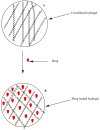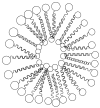Polymeric Nanocarriers for the Delivery of Antimalarials
- PMID: 30279405
- PMCID: PMC6222303
- DOI: 10.3390/molecules23102527
Polymeric Nanocarriers for the Delivery of Antimalarials
Abstract
Malaria is an infectious disease caused by a protozoan parasite which is transmitted by female Anopheles mosquitoes around tropical and sub-tropical regions. Half of the world's population is at risk of being infected by malaria. This mainly includes children, pregnant women and people living with chronic diseases. The main factor that has contributed to the spread of this disease is the increase in the number of drug-resistant parasites. To overcome drug resistance, researchers have developed drug delivery systems from biodegradable polymers for the loading of antimalarials. The drug delivery systems were characterized by distinct features such as good biocompatibility, high percentage drug encapsulation, reduced drug toxicity and targeted drug delivery. In this review article, we highlight the various types of drug delivery systems developed from polymeric nanocarriers used for the delivery of antimalarials.
Keywords: antimalarials; biodegradable polymers; drug delivery; drug resistance.
Conflict of interest statement
The authors declare no conflict of interest.
Figures








References
-
- WHO Malaria Factsheet updated January 2016. [(accessed on 18 February 2016)]; Available online: http://www.who.int/mediacentre/factsheets/fs094/en/.
-
- WHO Factsheet: Malaria Report 2015. [(accessed on 9 December 2015)]; Available online: http://www.who.int/malaria/media/world-malaria-report-2015/en/.
Publication types
MeSH terms
Substances
LinkOut - more resources
Full Text Sources

